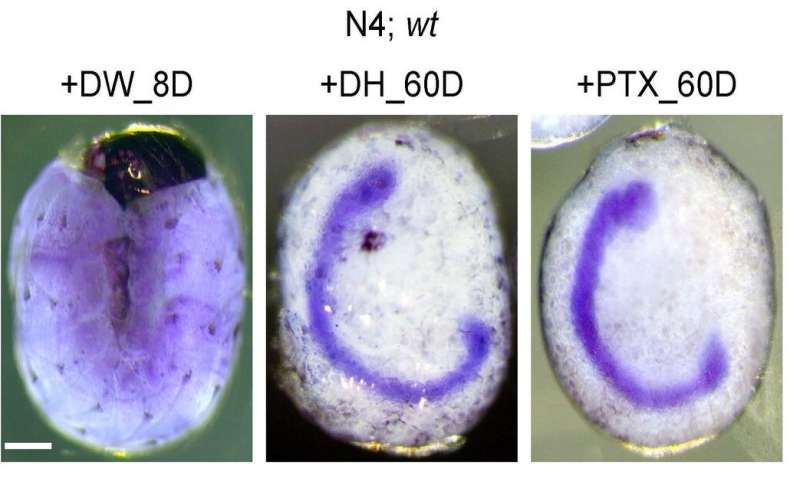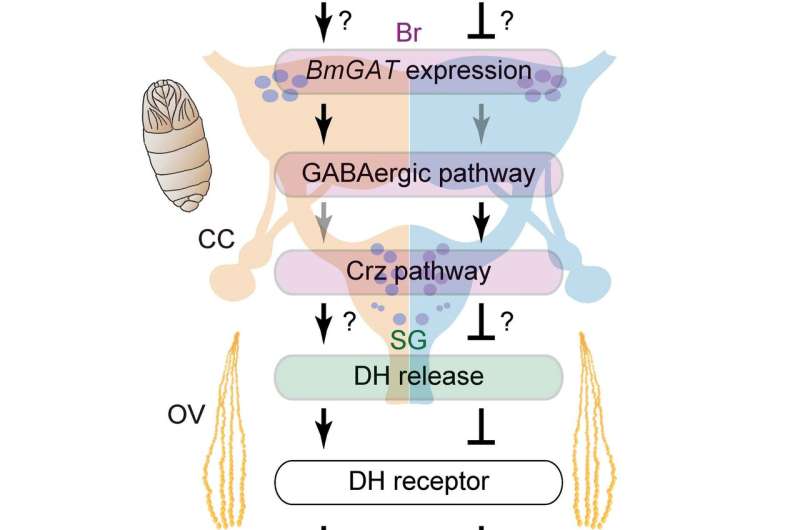Silkworm's brain determines diapause by thermal information

Diapause is a seasonal adaptation strategy of insects and animals in which biological functions are put on hold, such as insect eggs that remain dormant until conditions are more favorable to hatch. This is not a passive response of dormancy to adverse situations but an actively induced state that takes place well in advance in anticipation of natural conditions. Although it has been hypothesized that the neuroendocrine systems are associated with seasonal reproductive plasticity, the morphological, physiological, behavioral, reproductive responses of diapause remain unclear.
In a new study, silkworms (Bombyx mori) were found to lay diapause eggs at 25 degrees C and non-diapause eggs at 15 degrees C. Females were observed to determine whether to lay diapause eggs or not according to thermal information received by the embryonic Bombyx TRPA1 ortholog (BmTRPA1). Scientists have previously known that there is a chemical released from the brain to signal diapause. In this study, scientists at Shinshu University have elucidated that the neuropeptide corazonin regulates the release of the diapause hormone.
Associate Professor Shiomi of Shinshu University says, "We have revealed for the first time that corazonin is a key player in the production of dormant eggs due to temperature. Currently, we are investigating the higher-level mechanism of why the hormone secretion mechanism differs depending on the temperature. We have also begun research on the evolutionary process of that pathway. A series of studies revealed a part of the mechanism of the seasonal response of the brain in a wide range of insects and other animals. In the future, this novel information may be used in the control of insect reproduction and effective pest control."

Corazonin (Crz) is a neuropeptide that is in the same family of neuropeptides as the mammalian gonadotropin-releasing hormone (GnRH) known to control seasonal reproduction. The researchers found that Crz release is controlled by GABA neurotransmission and that temperatures during the egg period affect the GABA neurotransmission during the pupal period, which determines diapause. This predictive adaptive response or PARs is even observed in mammals including humans.
Silkworms are dimorphic insects, meaning they repeat a life cycle of two generations in one year. They are known to lay dormant eggs that stop normal development in the early stages of embryogenesis. This is determined by the maternal effect of thermal information which is memorized and stored. Crz is also known to slow the silk spinning rate of worms, suggesting it has multiple physiological functions.
More information: Ryoma Tsuchiya el al., "Maternal GABAergic and GnRH/corazonin pathway modulates egg diapause phenotype of the silkworm Bombyx mori," PNAS (2020). www.pnas.org/cgi/doi/10.1073/pnas.2020028118
Journal information: Proceedings of the National Academy of Sciences
Provided by Shinshu University




















